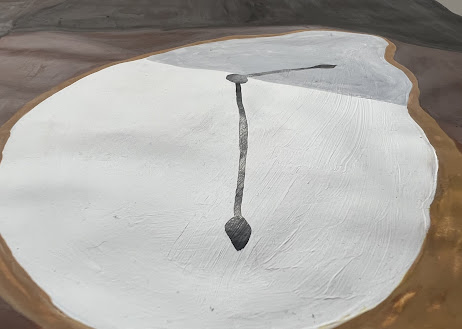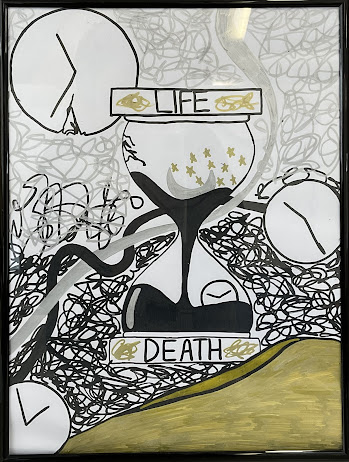Time in the art can be implied or can be actual time. Actual time includes time-based work and media, artwork that changes through time, and the effect of time on painting and how that affects its meaning. Implied time can be represented in the captured moment, evidence of time already passed, or an illusion of passing time. Recent technological developments have created many different forms of artistic possibilities such as video game art or visual art.
As well as time, art exists in space. Time implies change and movement; movement implies the passage of time. Movement and time, whether actual or an illusion, are crucial elements in art although we may not be aware of it. Artwork may incorporate actual motion; that is, the artwork itself moves in some way. Or it may incorporate the illusion of or implied movement. Contemporary artworks that include video, film, audio or computer technologies are referred to as time-based media works because they have duration as a dimension and unfold to the viewer over time. Movement is the path the viewer's eye takes through the work of art, often to focal areas. Such movement can be directed along lines, edges, shapes, and colours within the work of art. Artists use movement to control the viewer's eye through a work of art.
There are three (3) types of movement in art:
- Physical movement - This can be conveyed by drawing or painting lines from the moving object.
- Juxtaposition - The artist portrays the subject somewhat in a "freeze frame.” This type of movement can show the subject in the air, or at an angle.
- Moving the viewer's eye - Movement is dictated by how the objects are placed on the picture plane or by how the artist uses the elements of art throughout the artwork. Hokusai's Under the Wave off Kanagawa is an example of how an artist can move the viewer's eye.
Circular time shows a cycle or repeating pattern such as an analogue clock and a labyrinth. Motion in the art can be where the craft actually moves in a kinetic way or when art shows that an object is moving. Movement in art is expressed with blurry images, placement of things, and different use of lines.
A contemporary artist that worked with the concept of time is Felix Gonzalez-Torres, born in Guáimaro, Cuba. He lived and worked in New York City between 1979 and 1995. Gonzalez-Torres died in Miami on January 6, 1996, from AIDS-related causes. The University of Puerto Rico is where he began his art studies before moving to New York City, where he attended the Whitney Independent Study Program, first in 1981 and again in 1983. He received his BFA from Pratt Institute, New York, in 1983 and then in 1987, his MFA from the International Center of Photography and New York University.
All of Gonzalez-Torres' works, with some exceptions, are titled "Untitled" in quotation marks, sometimes followed by an interposed title. This was a titling scheme by the artist as "Untitled" was dedicated to Gonzalez-Torres's deceased lover, Ross Laycock, who died of an AIDS-related illness in 1991. Here are the guidelines the artist supplied to MoMA when the museum set to display his clock-related work:
“When installed, the two clocks were to touch; the clocks could be replaced with white plastic commercial clocks of similar dimensions and design; the minute and second hands were to be set in sync, with the understanding that eventually they might go out of sync during the exhibition; if one of the clocks needed the batteries replaced, it was to be done, and the clocks were to be reset accordingly; the clocks were to be displayed on a wall painted light blue.”
Dalí's artistic repertoire included painting, graphic arts, film, sculpture, design and photography, at times in collaboration with other artists. He also wrote fiction, poetry, autobiography, essays and criticism. Major themes in his work include dreams, the subconscious, sexuality, religion, science and his closest personal relationships.
For this project, I have centred my pieces around the concept of time, such as The Persistence of Memory, becoming heavily inspired. For example, I can replicate the golden pocket watch on the left that has melted down the side of the surface it is sitting on. I have decided to not let this piece of work be an exact replica of the original image because this could represent the fact that it looks like I ran out of time whilst making this. In contrast, the original image had a lot of time working with this to make as detailed and realistic as possible.
The orange clock at the bottom left of the painting is covered in ants. In many regions, ants represent willpower, patience, cooperation, and power, but Dalí often used ants in his paintings as a symbol of decay, which happens to old, dead or rotting things over some time. Another insect in the painting is a fly, which sits on the watch next to the orange watch. The fly appears to cast a human shadow as the sun hits it. The Persistence of Memory uses realist painting techniques to depict imagery more likely to be found in dreams than in waking consciousness. I could add these smaller details and potentially make the clock look worn down or disfigured on purpose, so it shows the process of time and what can happen during the period.
A consistent shape in this image is a circle or spherical shape, albeit looking second or third-dimensional. If one was to touch this piece of work, one would realise that most of it would have a rough texture, even if it looks smooth. From the top to the bottom of the image, we see a pattern of brighter colours at the top. In contrast, the darker ones are at the bottom, the darker colours at the bottom can represent the decay process again, whereas the brighter colours towards the top can represent the goodness in life.
During this project, I continued to experiment with different types of media, such as painting, lino prints and real objects, using different kinds of papers and cards to give each creation a different texture and feel. But I have also decided to focus on moments in time, such as people doing something or something symbolic of something that has happened in the past, such as a death or birthday.
The first thing I made in this project to help conjure up some ideas, is what represents time; life, death and types of clocks, like an hourglass. An hourglass is an idea I have used throughout. But whilst working on the lino prints, I had not realised that the image would print backwards on the final product. But I eventually concluded that it could work well as only some things to do with time look correct, such as facing forward. Sometimes it can face backwards and not look stereotypically average. So on one of these prints, I have written the words facing the way they should be, this can represent the duality of time and how it can be shown no matter where in time it is set. But with the colour scheme, I decided to experiment with colours to see what colour goes well with what. But I decided to stick with black and white because the two colours can be a stereotypical representation.
On the stencil of the Lino print, I have included the sun and moon. The sun represents life but it's also known to typify energy, power, positivity, and clarity. The sun is a natural force that's outside our control, but it also illuminates the world around us, helps living creatures navigate the planet, and sustains many essential ecosystems. The sun signifies time and life, but the sun being at the bottom of the image, shows that the day is beginning or ending, and time is passing. This is also shown by the moon at the top of the image, and the moon universally represents the rhythm of time as it embodies the cycle. The phases of the moon symbolize immortality and eternity, enlightenment or the dark side of nature itself as well as completion, fertility, abundance, and transformation, which, again, all takes time.
Involving the concept of time, life and death in this project, I researched things that have to do with the concepts. Such as flowers that represent life and death, like lilies, chrysanthemums and roses, daffodils and pansies. As well as a skull, that purely represents the loss of life with pure death, and I decided to combine them together thus making a floral-like grave with flowers growing around them. Whilst making this artwork, I realised that the moon in the corner does not work, so when I made a second attempt, I replicated the skull but with different flowers and their positioning and made the image bigger, not including the moon.
While conjuring ideas for this project, I used quotations about time on some paper before making it look old, dishevelled and aged. But the structure of these pieces of paper reminds me of Dalí's The Persistence of Memory, because of how the original painting has melted clocks, and these pieces of paper look melted and broken down just like the clocks. These quotations have the theme of making the viewer think about these words and make them think about what else they could mean. To make the words bold and stand out to the viewer I used a black acrylic paint pen and graphite pencils to make the paper look old. And the look of these pieces of paper reminds me of the first photograph taken by Joseph Nicéphore Niépce.





































No comments:
Post a Comment